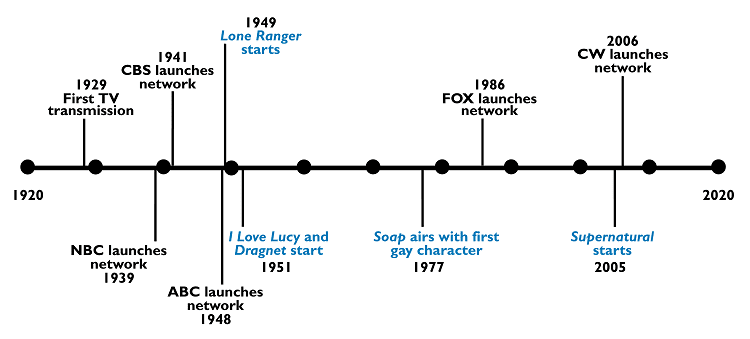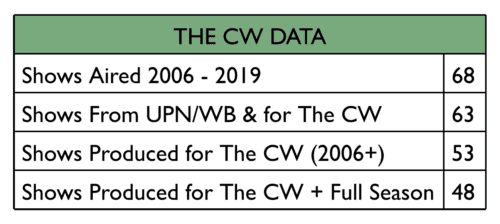The last few years have seen an uptick of LGBTQ identified characters, especially in Peak TV. In almost 70 years of TV, only 41 have had LGBTQ characters! This season, all but three of The CW’s shows will have main or heavily recurring LGBTQ characters. In its twelve year existence, The CW introduced LGBTQ characters in 75% of the shows airing a full season. US television has come a long way since the first gay character’s introduction in 1977. With of course much more to go.
For example, Caroline Framke wrote for Vox about the sheer number of deaths during Spring Slaughter 2016. LGBTQ identified women accounted for 10% (!) of the deaths, with the most infamous being Lexa. Characters need to be fully realized people with their own motivations and not end up dead more than their straight counterparts.
However, this piece isn’t about the actual representative values of the characters*. Instead, I look at the barely 70 year TV history that has led to Pose in 2018. And next year, likely the premiere of Batwoman. The first superhero show about and starring a lesbian woman.
Brief TV History

NBC launched in 1939 but the first scripted primetime series started in 1949 (Lone Ranger). The first and ever-present procedural Dragnet premiered only two years later.
Soap on ABC introduced the first gay character 27 years later. Ellen’s coming out on her own sitcom aired in 1997. March of this year had CBS premiere Instinct where Alan Cumming portrays Dr. Dylan Reinhardt, a gay man.
The 80s saw an increase in recurring and even some main LGB characters, particularly on NBC and ABC. FOX’ Party of Five introduced Ross Werkman in 1994. (Though the actual storylines for a majority of the characters were terribad.) Even CBS had a few characters (however on failed shows) in the 90s. Their first semi-recurring gay character was on NCIS starting in 2011 and then he died… On the flip side, The Good Wife gave us Kalinda Sharma (and others) in 2009.
Around 2004/2005 the other big 3 began regularly introducing LGBTQ characters as more than one episode cameos or short recurring plotlines with actual series leads and the first time a trans actress portrayed a trans character in ABC’s Dirty Sexy Money (2007).
2007 brings us to a year after The CW started airing its own productions. Alongside ten properties brought over from the WB and UPN. Both networks too in the mid-2000s had introduced LGBTQ characters on a handful of shows. Like Veronica Mars and Gilmore Girls to name the most popular ones. The CW premiered two shows (The Game and Runaway) with the UPN/WB programs and neither had any LGBTQ characters. Runaway only aired three episodes so no way to tell if it would have later in time.
The CW’s Introduction of LGBTQ Characters

Above is data for The CW’s shows since 2006. Five shows were sold to The CW by other networks to air. Of the 48 shows that received pick-ups directly from The CW and aired a full season, 75% introduced LGBQ characters with Supergirl set to introduce the first transgender character in Nia Nal. Every year since 2007 multiple shows introduced LGBQ characters and for the last two years every show introduced at least one lead LGBQ character. (In the Dark premieres in the spring so I can’t speak to 2018-2019 quite yet.)
Obviously, The CW has the shortest history of the five broadcast networks. It is the first “fifth” network to make it past 10 years. Both UPN and WB were combined to form the CW in their tenth year. Funnily enough, both of these networks were launched ten years after FOX which became the first successful fourth network after 18 (!) failed attempts to compete with the Big 3.
So why the asterisk in my third paragraph? Originally this article was going to look at the representation of LGBTQ characters on The CW precisely because twelve years is a short moment in TV’s almost 70-year history. I wanted to write a follow up to my piece on The CW’s recent treatment of LGBTQ characters written in 2016. The recent introduction of characters like Anissa, JR, Petra (realizing her love for JR), and Mel (plus firing of certain showrunners) indicates a movement towards doing better.
Then I started looking and the number of CW shows with at least one recurring LGBTQ character shocked me! Cue the realization of just how many characters I’d have to look up in 36 shows and I decided that I love myself too much to go through that endeavor for a short article. (Maybe a thesis one day!)
On the other hand, while I knew NBC’s history as the first broadcast network, I had no idea about the other milestones on the timeline. So here we are, a short history on TV’s short history.
Thanks to Peak TV and certain showrunners working to introduce LGBTQ characters to broadcast, cable, and streaming, the next few years will likely see even more shows led by LGBTQ characters. I hope that in a hundred years of TV retrospective the 2019 to 2049 portion of the timeline will have an overwhelming majority of positive portrayals as compared to the 1977-2007 period. Even right now for as great as some portrayals are, so many are just not.
Still, the last five years have seen some spectacular characters come and go and I’m excited to see what the next 31 years of TV brings us. That is if broadcast TV as it is lasts that long!

